Blog - Hollow Bone Records

5 Essential Hip Hop Albums You Need on Vinyl
Vinyl collecting in hip hop is more than just the music—it’s about embracing the culture, the art, and the raw sonic experience that can only come from a record spinning on a turntable. Here are five essential hip hop albums that every vinyl collector should own, each bringing its unique legacy and sound to your collection.
Clipse – Let God Sort Em Out
Let God Sort Em Out is a striking comeback album from Clipse, blending their classic lyrical prowess with moody, cinematic production. The album delivers tightly crafted verses and complex flows from Pusha T and Malice, wrapped around Pharrell's innovative beats. On vinyl, the atmospheric depth and gritty textures of this seven-track project really stand out, making it a powerful addition for serious collectors.
MF Doom – MM…Food
MF Doom’s MM…Food is a beloved underground classic that cleverly blends playful food-themed metaphors with complex rhyme schemes and smooth production. The album’s lo-fi beats and DOOM’s distinctive flow make it a standout in underground hip hop. Experiencing this record on vinyl heightens the warmth and rawness that suits Doom’s iconic style perfectly.
Kendrick Lamar – GNX
Kendrick Lamar’s GNX showcases the versatility and sharp storytelling that has made him one of the most influential voices in modern hip hop. This album offers a blend of thought-provoking lyricism and innovative production. On vinyl, the dynamic range and thoughtful layering of sounds come through with vivid clarity, making it a must-have for any hip hop collector.
OutKast – Stankonia
Stankonia is a groundbreaking album by OutKast that pushes the boundaries of hip hop with funk, soul, and psychedelic elements fused into their southern style. It features iconic tracks that have aged into classics. Vinyl enthusiasts love how Stankonia’s rich, vibrant soundscape gets amplified, providing a deep, immersive listening experience.
Eminem – The Marshall Mathers LP
This landmark album put Eminem at the forefront of hip hop with its raw honesty and storytelling. The Marshall Mathers LP combines angry, provocative lyrics with dark, compelling production. On vinyl, the dynamics and intensity of the album’s tracks come to life, letting listeners connect deeply with its emotional and artistic power.
Frequently Asked Questions
Why should I invest in hip hop vinyl records?
Vinyl records offer superior sound quality with warm, authentic audio that digital formats often fail to replicate. Owning vinyl also connects you to the culture and history of hip hop on a deeper level.
Can I find these albums at Hollow Bone Records?
Absolutely! Hollow Bone Records curates an extensive collection of essential and rare hip hop vinyl albums, including these five classics.
What makes these albums “essential”?
These albums represent pivotal moments in hip hop history, showcasing innovation, storytelling, and influence that shaped the genre’s evolution.
Conclusion
For collectors and fans alike, these five hip hop albums are essential vinyl treasures that provide a full spectrum of the genre’s depth and creativity. Hollow Bone Records invites you to explore our hip hop vinyl collection, where you can discover these albums and many more to enrich your vinyl library. Embrace the culture and sound of hip hop with every spin.

6 Must-Have Punk Albums for Every Vinyl Collector
If you’re diving into the world of punk vinyl records, there are a few cornerstone albums that every enthusiast should own. These records capture the raw energy, social commentary, and groundbreaking sound that define punk rock. Here are six must-have punk albums that deserve a spot in any vinyl collector's rotation.
The Clash - London Calling
A timeless classic, London Calling showcases The Clash at their songwriting peak, blending punk with reggae, ska, and rockabilly influences. The album’s gritty sound and politically charged lyrics make it a profound statement of its era. Its iconic double LP format and striking cover art make it a treasure on vinyl.
Television - Marquee Moon
Marquee Moon is essential for those who appreciate punk’s more artful and guitar-driven edge. This record introduced a more intricate, atmospheric sound while maintaining punk’s urgency. Collectors prize its crisp production and detailed musicianship that’s best experienced on vinyl.
Green Day - Dookie
Dookie is the album that brought punk rock into the mainstream in the ’90s. Its catchy hooks and rebellious spirit made it a definitive punk record for a new generation. The raw energy packed into tracks like “Basket Case” shines through on vinyl, capturing the essence of youthful angst.
Descendents - Milo Goes to College
Milo Goes to College combines fast-paced punk with clever, often humorous lyrics. This album captures the heart of punk’s DIY ethos and melodic aggression. Its brevity and sincerity resonate with dedicated punk fans, making its vinyl edition a collector's favorite.
Social Distortion - Social Distortion
The self-titled album from Social Distortion is a perfect blend of punk, rockabilly, and blues. Its honest storytelling and gritty sound create a unique punk vibe that’s both timeless and influential. Vinyl listeners enjoy the album’s rich textures and authentic feel.
Frequently Asked Questions
What makes vinyl punk albums special?
Vinyl captures the raw, analog sound and atmosphere that digital formats often miss. The tactile experience of vinyl enhances the connection to punk’s rebellious roots.
Are these albums available at Hollow Bone Records?
Yes! Our punk vinyl collection proudly features all these essential albums and more for collectors and new fans alike.
Why should I start collecting punk vinyl records?
Collecting punk vinyl offers a unique way to experience the music’s energy and history. Plus, original pressings and special editions can be valuable over time.
Conclusion
Whether you're just starting your punk vinyl journey or expanding a seasoned collection, these six albums are foundational. At Hollow Bone Records, we are passionate about punk music and proud to offer an extensive selection of punk vinyl that captures the spirit and energy of this revolutionary genre. Explore our collection and find your next favorite punk record today.
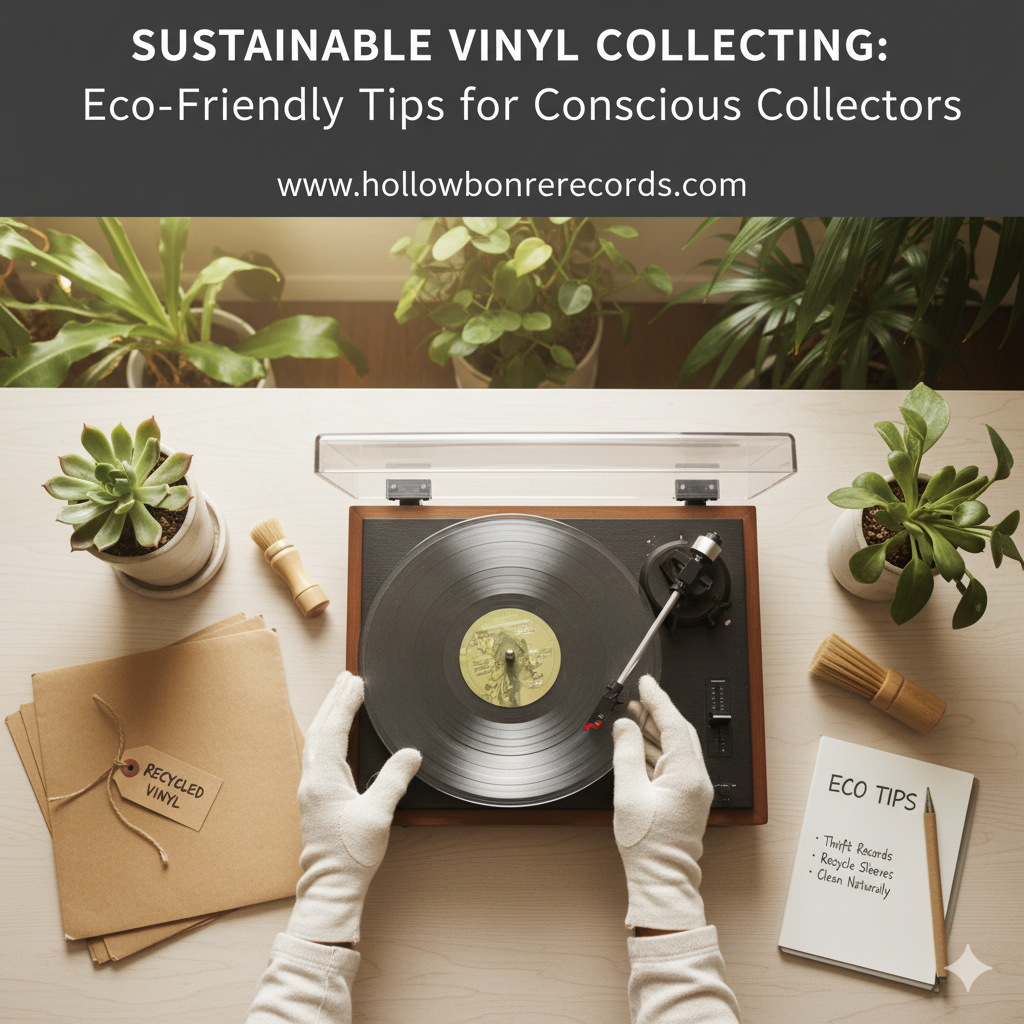
Sustainable Vinyl Collecting: Eco-Friendly Tips for Conscious Collectors
Vinyl records have experienced a resurgence in recent years, captivating both seasoned audiophiles and new enthusiasts. However, as the popularity of vinyl grows, so does its environmental impact.
Traditional vinyl records are made from polyvinyl chloride (PVC), a plastic that poses challenges in terms of recyclability and environmental sustainability.
In this article, we'll explore practical and eco-friendly tips to help you enjoy your vinyl collection while minimizing your ecological footprint.
1. Opt for Eco-Friendly Vinyl Pressings
When adding to your collection, consider choosing records made from sustainable materials. Some pressing plants are now producing vinyl using recycled materials or alternative substances like PET (polyethylene terephthalate), which is more recyclable than PVC Movacolor. Artists like Billie Eilish have also advocated for environmentally conscious pressing methods, encouraging the industry to adopt greener practices Imagine5.
2. Support Labels Committed to Sustainability
Research and support record labels that prioritize sustainability in their production processes. Labels that use eco-friendly materials, energy-efficient equipment, and sustainable packaging contribute positively to the environment. By purchasing from these labels, you encourage the industry to adopt more sustainable practices.
3. Care for Your Records to Extend Their Lifespan
Proper maintenance of your vinyl records can significantly reduce the need for replacements. Regularly clean your records with appropriate tools, such as carbon fiber brushes, and store them in a cool, dry place away from direct sunlight. Using high-quality inner sleeves can also protect your records from dust and scratches, ensuring they last longer.
4. Recycle or Repurpose Old Records
Instead of discarding damaged or unwanted records, consider recycling or repurposing them. Some companies specialize in recycling vinyl records into new products, such as eco-friendly packaging or even new vinyl pressings. Alternatively, you can get creative and turn old records into art pieces, coasters, or wall clocks, giving them a second life and reducing waste.
5. Choose Sustainable Packaging Options
When purchasing vinyl records, opt for those that come in sustainable packaging. Look for biodegradable sleeves, recycled paper inserts, and minimal plastic use. Additionally, when shipping records, choose eco-friendly packaging materials like recycled cardboard and paper mailers to reduce environmental impact.
6. Support Local Record Stores
Buying from local record stores not only supports small businesses but also reduces the carbon footprint associated with shipping products over long distances. Many local shops are also more likely to carry eco-friendly products and can offer personalized recommendations based on your sustainability preferences.
7. Educate Yourself and Others
Stay informed about the environmental impact of vinyl records and share this knowledge with fellow collectors. By raising awareness, you can encourage more people to make sustainable choices in their collecting habits, leading to a collective positive impact on the environment.
Quick Takeaways
-
Opt for vinyl records made from recycled materials or alternative plastics like PET.
-
Support record labels and artists committed to sustainable practices.
-
Properly care for your records to extend their lifespan and reduce waste.
-
Recycle or repurpose old records instead of discarding them.
-
Choose sustainable packaging options when purchasing or shipping records.
-
Support local record stores to reduce shipping-related carbon emissions.
-
Educate yourself and others about the environmental impact of vinyl collecting.
Conclusion
Sustainable vinyl collecting is about making informed choices that align with environmental consciousness. By opting for eco-friendly pressings, supporting responsible labels, and caring for your collection, you can enjoy the rich sound of vinyl while minimizing your ecological footprint. Remember, every small action contributes to a larger positive impact on our planet.
For those interested in expanding their collection with sustainable options, explore our curated selection of eco-friendly vinyl records at Hollow Bone Records.
FAQs
1. Are all vinyl records made from PVC?
Most traditional vinyl records are made from PVC, but some pressing plants are now using alternative materials like recycled PET to reduce environmental impact.
2. How can I tell if a vinyl record is eco-friendly?
Look for labels or information on the packaging indicating the use of recycled materials, biodegradable packaging, or sustainable production practices.
3. Can I recycle old vinyl records?
Recycling options for vinyl records are limited due to the materials used. However, some companies specialize in recycling vinyl into new products. Alternatively, consider repurposing old records creatively.
4. Does buying vinyl records contribute to plastic waste?
Yes, traditional vinyl records contribute to plastic waste. However, by choosing eco-friendly options and supporting sustainable practices, you can mitigate this impact.
5. How can I support sustainable practices in the vinyl industry?
Support record labels and artists committed to sustainability, choose eco-friendly products, and raise awareness about the environmental impact of vinyl collecting.
We'd Love to Hear from You!
Have you adopted any sustainable practices in your vinyl collecting? Share your experiences and tips with us in the comments below. Don't forget to share this article with fellow collectors to spread the word about eco-friendly vinyl collecting!
References
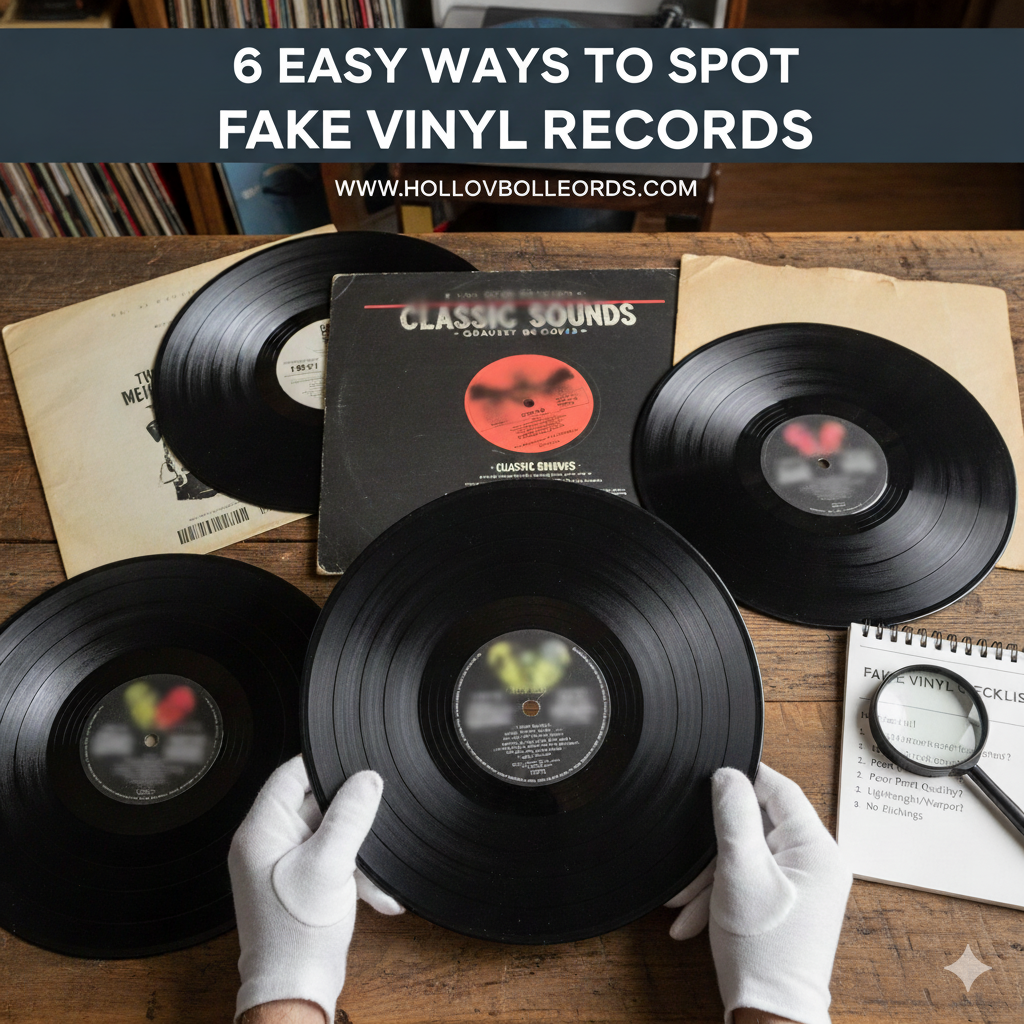
6 Easy Ways to Spot Fake Vinyl Records
Vinyl records have experienced a resurgence in popularity, attracting both seasoned collectors and new enthusiasts. However, with this revival comes the unfortunate rise of counterfeit vinyls flooding the market.
These fakes not only deceive buyers but also tarnish the rich history and authenticity that vinyl represents. In this guide, we'll delve into effective methods to identify counterfeit vinyl records, helping you make informed purchasing decisions.
1. Examine the Cover Art and Packaging
-
Artwork Quality: Authentic vinyl covers typically showcase sharp, high-resolution artwork. Blurry, pixelated, or overly bright images can be indicative of a counterfeit. Additionally, check for any spelling errors or unusual fonts.
-
Material and Feel: Genuine albums often use sturdy, high-quality materials for their covers. If the cover feels flimsy or the printing appears cheap, it's a red flag.
-
Spine Text Alignment: The text on the spine should be clear and properly aligned. Misaligned or blurry text can signal a fake. (Retrolife Official Store)
2. Inspect the Vinyl Itself
-
Weight and Thickness: Original pressings are usually heavier and thicker than counterfeit records. While this isn't always a definitive test, it can be a helpful indicator.
-
Surface Quality: Check for imperfections like streaks, bumps, or warps. Counterfeit records often have poor manufacturing quality. (Vinyl Record Manufacturers Association)
-
Run-Out Groove Details: Examine the area between the last track and the label (run-out groove). Authentic records often have machine-stamped matrix numbers and engineer's stamps here. Handwritten or absent markings can indicate a counterfeit. (What Hi-Fi?)
3. Check the Label and Center Hole
-
Label Design: Original labels will have clear, sharp text and images. Look for any discrepancies in font, color, or design. Pay attention to the center label; it should be perfectly centered and not easily peelable.
-
Catalog Number: Verify the catalog number on the label. Counterfeit records often have incorrect or missing catalog numbers.
4. Assess the Sound Quality
-
Audio Clarity: Play the record and listen closely. Authentic records typically have clear and well-defined sound. Counterfeit records may have distorted, muffled, or low-quality audio.
-
Background Noise: While all vinyl records have some degree of background noise, excessive pops, clicks, or static can indicate a poor-quality pressing, often characteristic of fakes.
5. Investigate the Seller's Reputation
-
Trusted Sellers: Always consider who you're buying from. Trusted sellers with good reviews are less likely to sell fake records.
-
Seller Transparency: Be cautious if the seller has limited feedback or is unwilling to provide detailed photos. A reputable seller should be transparent about the product's condition and provenance.
6. Utilize Online Databases
-
Discogs: Use platforms like Discogs to check the catalog number and other details of the record. If the record is listed as "unofficial" or "bootleg," it's likely a counterfeit. (ipo.blog.gov.uk)
-
Comparison: Compare the suspect record with known authentic copies. Look for differences in cover art, label design, and other details. This can help identify discrepancies indicative of a fake.
Quick Takeaways
-
Always inspect the cover art for quality and accuracy.
-
Examine the vinyl for weight, thickness, and surface imperfections.
-
Check the label and center hole for authenticity markers.
-
Assess the sound quality during playback.
-
Research the seller's reputation and transparency.
-
Utilize online databases to verify catalog numbers and authenticity.
Conclusion
Spotting counterfeit vinyl records requires attention to detail and a discerning eye. By examining the cover art, vinyl quality, label details, sound performance, and the seller's credibility, you can protect yourself from purchasing fakes. At Hollow Bone Records, we pride ourselves on offering genuine, high-quality vinyl records to our customers. For a curated selection of authentic vinyl, visit our collection page. Remember, when in doubt, always research and verify before making a purchase.
FAQs
-
What is the difference between a bootleg and a counterfeit vinyl record?
A bootleg is an unauthorized recording, like live performances or unreleased tracks, while a counterfeit is a fake reproduction of an official album made to deceive buyers. (Vinyl Record Manufacturers Association)
-
How can I verify the authenticity of a vinyl record online?
Utilize online databases like Discogs to check the catalog number, matrix numbers, and other details of the record. If the record is listed as "unofficial" or "bootleg," it's likely a counterfeit. (ipo.blog.gov.uk)
-
Are colored vinyl records more likely to be counterfeit?
Not necessarily, but counterfeiters often use colored vinyl to make records seem more collectible. If a colored vinyl pressing is not listed in official databases or lacks proper documentation, it could be a fake. (What Hi-Fi?)
-
What should I do if I suspect a vinyl record is counterfeit?
Contact the seller with your concerns and request additional information or photos. If the seller is uncooperative or defensive, consider reporting the issue to the platform where the purchase was made.
-
Can counterfeit vinyl records damage my turntable?
Yes, counterfeit records are often made from low-quality materials and can have imperfections that may damage your turntable's stylus or cause excessive wear.
We Value Your Feedback
Your opinion matters to us! If you've found this guide helpful or have additional tips on spotting counterfeit vinyl records, please share your thoughts in the comments below. Don't forget to share this article with fellow vinyl enthusiasts to help them make informed purchasing decisions.
References
-
How to Spot Counterfeit Vinyl Records. VRMA Group. (Vinyl Record Manufacturers Association)
-
How to spot fake records: 10 tips to avoiding counterfeit vinyl. What Hi-Fi?. (What Hi-Fi?)
-
Spotting Pirated Vinyl Records: How To Avoid Counterfeits. ShutterGroove. (ShutterGroove)
-
Spinning lies: the rise of fake vinyl and how industry is fighting back. Intellectual Property Office. (ipo.blog.gov.uk)
-
How to identify authentic vinyl records and avoid bootlegs? Retro Life Player. (Retrolife Official Store)

What Does Your Music Taste Say About You? A Vinyl Horoscope
Aries (March 21 - April 19)
Musical Style: High-energy rock, punk, hardcore, aggressive hip-hop
Taurus (April 20 - May 20)
Musical Style: Soul, jazz, classic rock, high-quality audiophile recordings
Gemini (May 21 - June 20)
Musical Style: Eclectic mixes, new wave, clever lyricists, genre-blending artists
Cancer (June 21 - July 22)
Musical Style: Emotional ballads, folk, classic pop, comforting melodies
Discover Your Cosmic Soundtrack
Whether you follow astrology closely or simply enjoy exploring new music, these vinyl recommendations offer something for every musical taste. The connection between personality and musical preference reveals how deeply music is intertwined with our identities.
Explore these albums and many more in our curated collection, featuring both new pressings and rare finds for the discerning collector.
Explore Our Vinyl CollectionNote: This musical horoscope is intended for entertainment purposes. The best music is ultimately what resonates with you personally, regardless of astrological signs.
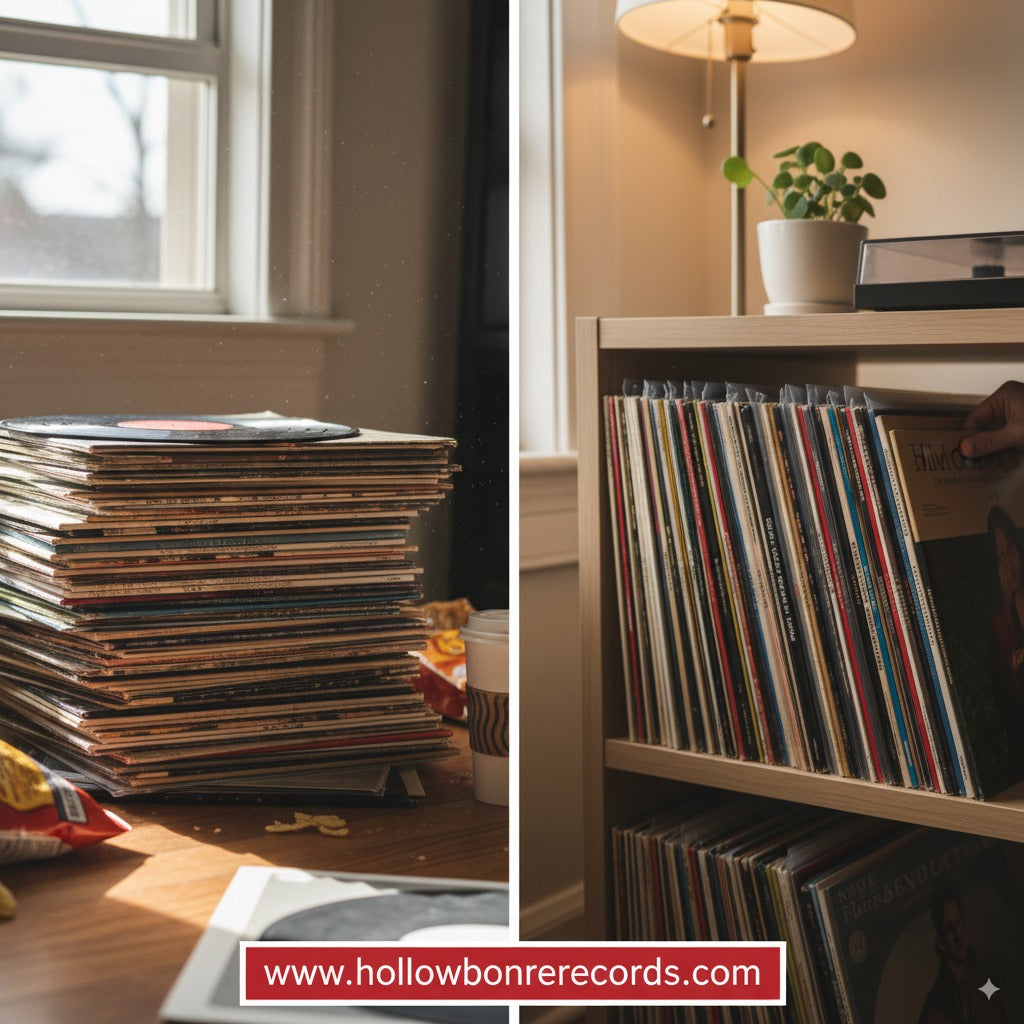
5 Mistakes Every New Vinyl Collector Makes (And How to Avoid Them)
Beginning a vinyl collection can be an exciting journey into the world of music appreciation. However, many new collectors encounter common pitfalls that can affect both their enjoyment and investment. Understanding these potential mistakes can help create a more rewarding collecting experience.
Prioritizing Visual Appeal Over Sound Quality
The Issue
Many newcomers gravitate toward colored vinyl or picture discs due to their visual appeal. While these specialty pressings can be attractive, they sometimes sacrifice audio quality. The additives that create colored vinyl can potentially affect the sound reproduction compared to traditional black vinyl.
The Solution
Research pressing quality before purchasing special editions. Standard black vinyl often provides the most consistent audio performance. When considering colored variants, look for reviews that specifically address sound quality rather than just appearance.
Inadequate Record Cleaning and Maintenance
The Issue
New collectors often underestimate the importance of proper vinyl maintenance. Dust, static electricity, and fingerprints can accumulate, degrading sound quality and potentially damaging records over time. Improper cleaning methods can actually cause more harm than good.
The Solution
Establish a regular cleaning routine using appropriate tools. A carbon fiber brush should be used before each play to remove surface dust. For deeper cleaning, invest in specialized record cleaning solutions and microfiber cloths designed specifically for vinyl.
Purchasing Without Prior Listening
The Issue
The excitement of building a collection quickly can lead to impulse purchases based on trends or recommendations rather than personal musical taste. This often results in records that are rarely played, representing both wasted storage space and unnecessary expense.
The Solution
Stream albums multiple times before committing to vinyl purchases. Focus on acquiring music that has lasting appeal rather than following temporary trends. Creating a want list of genuinely enjoyed albums helps maintain focus and prevents impulse buying.
Overlooking Condition Assessment
The Issue
Record grading can be subjective, and newcomers may not fully understand the differences between various condition ratings. A record described as having "minor surface noise" might have imperfections that significantly impact listening enjoyment, especially on quieter passages of music.
The Solution
Learn standard grading terminology and always request detailed condition reports when purchasing online. When possible, examine records in person before buying. Starting with records graded VG+ or higher provides a better listening experience while learning to assess condition.
Emphasizing Quantity Over Quality
The Issue
There can be temptation to rapidly expand a collection with numerous inexpensive records. However, this approach often results in accumulating albums of lesser musical interest or inferior pressing quality, ultimately diminishing the overall collection value and enjoyment.
The Solution
Focus on building a curated collection of records that will receive regular play. Establishing a monthly budget helps maintain discipline and encourages more thoughtful purchasing decisions. A smaller collection of beloved albums typically provides more satisfaction than a large collection of seldom-played records.
Building a Thoughtful Vinyl Collection
Developing a meaningful record collection requires patience, knowledge, and careful consideration. By avoiding these common mistakes, new collectors can build a selection of vinyl that provides lasting enjoyment and value.
For those beginning their vinyl journey, a curated selection of quality pressings is available, featuring both contemporary releases and classic albums. Knowledgeable staff can provide guidance on both music selection and proper vinyl care.
View Vinyl CollectionCollecting vinyl represents not just ownership of music, but engagement with the physical artifact and audio quality. With careful attention to these aspects, the hobby can provide decades of listening pleasure.
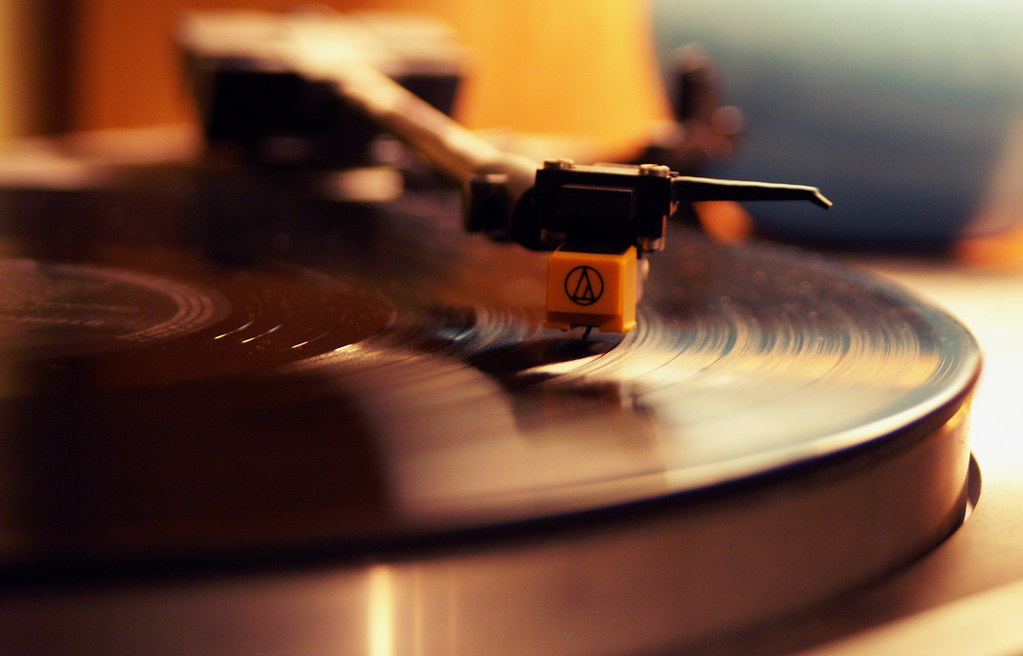
Struggling with Static on Vinyl? Try These Genius Fixes
That annoying crackle and pop between tracks isn't part of the music - it's static electricity wreaking havoc on your listening experience. Static is the silent killer of vinyl sound quality, especially in dry climates. But before you resign yourself to constant crackles, try these surprisingly effective static solutions that actually work.
1. The Wet Cleaning Method (Not What You Think)
Standard dry brushing won't cut it for static. Try this pro technique:
-
Make a cleaning solution: 3 parts distilled water to 1 part isopropyl alcohol (91%)
- Apply with a soft paint pad (the kind for cutting in edges)
- Rinse with distilled water and dry immediately with microfiber
Why This Works: The slight conductivity of the solution neutralizes static charges while cleaning away dust that holds the charge.
2. The Anti-Static Sleeve Upgrade
Your record sleeves might be the problem:
| Sleeve Type | Static Reduction |
|---|---|
| Original Paper | None - actually generates static |
| Basic Plastic | Minimal |
| Anti-Static Polyethylene | Excellent |
| Rice Paper Composite | Best - archival quality |
3. The Humidifier Hack
Static thrives in dry air. Try these environmental fixes:
- Keep room humidity between 45-55% (use a hygrometer)
- Place a small humidifier near your listening area
- In a pinch: drape a damp towel over a nearby chair
4. The Zero-Cost Grounding Trick
Sometimes the simplest solutions work best:
- Before playing, touch your turntable's metal parts
- Hold the record by the edges and label while placing it
- After cleaning, leave the record uncovered for 2 minutes
5. The Secret Weapon: Anti-Static Guns
For serious collectors, these are game-changers:
Milty Zerostat 3: The gold standard - $70 but lasts decades
How it works: Creates a neutralizing ion blast with each trigger pull
Pro tip: Use before playing and after cleaning
Prevention: Stop Static Before It Starts
Build these habits into your routine:
- Always handle records by edges and label
- Store vertically (stacking creates static)
- Use inner and outer anti-static sleeves
- Clean new records before first play (factory release agents cause static)
When All Else Fails: The Last Resort
For stubborn static on valuable records:
Ultrasonic Cleaning: Professional services can eliminate static that home methods can't touch. Expect to pay $2-5 per record.
Final Thoughts
Static doesn't have to ruin your vinyl listening experience. With these methods - from simple grounding tricks to proper humidification - you can enjoy crackle-free playback.
Remember: Static-free records start with proper storage. Check out Hollow Bone Records for albums that come in premium anti-static packaging as standard.

Why Your Vinyl Sounds Bad (And How to Fix It)
That crackle, pop, or muffled sound ruining your listening experience? Don't blame the medium - vinyl records can sound incredible when properly set up. Most audio issues come down to a few common (and fixable) problems. Let's diagnose your bad vinyl sound and get your records singing properly again.
1. Dust & Static: The Silent Sound Killers
Those annoying crackles between songs? Usually just dirt. Here's your cleaning toolkit:
- Anti-static brush: Use before every play
-
Deep cleaning: Try a spin clean system or DIY with:
- Distilled water
- Soft paint edger as applicator
- Distilled water
Record Cleaning Hack: For stubborn static, wipe sleeves with a dryer sheet before returning records.
2. Your Needle Might Be Worn Out
A bad stylus can make even mint records sound dull. Check for:
- Hours used: Replace after 500-1000 hours
- Visible damage: Use a magnifier to check for bent cantilevers
- Sound clues: Sibilance distortion ("S" sounds harsh)
3. Turntable Setup Issues
Incorrect settings destroy sound quality. You need:
✓ Proper tracking force (check your cartridge specs)
✓ Anti-skate set correctly (usually matches tracking force)
✓ Level turntable (use a bubble app on your phone)
4. The Phono Stage Problem
That tinny, quiet sound? You might be missing proper phono preamplification:
- Built-in preamps (on cheap turntables) often sound terrible
- Solution: Try an external phono preamp
- Pro test: Compare with a friend's quality setup
5. Bad Pressings & Wear
Sometimes it's not your gear. Recognize these unfixable issues:
Non-fill: Manufacturing defect causing consistent distortion
Groove wear: Plays fine but sounds muffled (from heavy use)
Modern reissues: Some use digital masters that sound flat
Quick Sound Fix Cheat Sheet
| Problem | Likely Cause | Fix |
|---|---|---|
| Crackles throughout | Dirty record | Deep clean |
| Muffled highs | Worn stylus | Replace needle |
| Distortion on loud parts | Incorrect tracking force | Re-balance tonearm |
When to Upgrade Your Gear
If you've tried everything and still get bad sound, consider:
- Turntable: Upgrade from suitcase players (they damage records)
- Cartridge: Moving magnet to moving coil upgrade
- Speakers: Often the weakest link in the chain
Final Thoughts
Great vinyl sound comes from proper care and setup. Start with cleaning, check your stylus, and work through these solutions.
Remember - when sourced and maintained properly, vinyl should sound warm, detailed, and alive. If you're building a quality collection, browse Hollow Bone Records for audiophile-approved pressings.
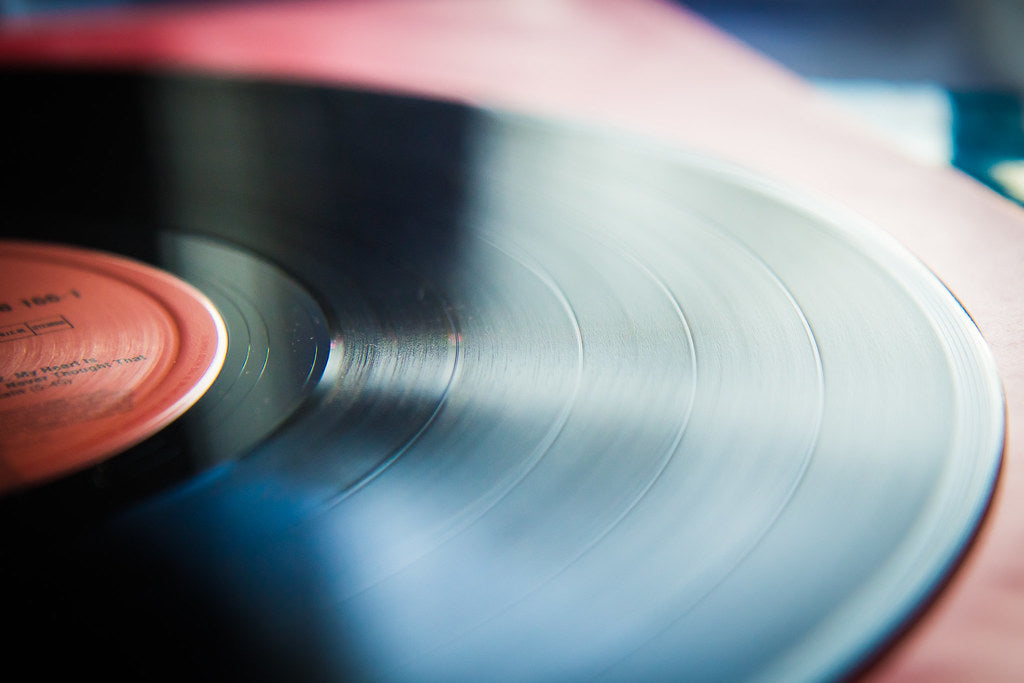
Vinyl Skipping? Here’s How to Fix It Fast
That heart-sinking moment when your favorite record starts jumping grooves - we've all been there. Before you blame the pressing or retire the record to your wall art collection, try these quick fixes for vinyl skipping. Most skips aren't permanent, and with the right approach, you can often get your records spinning smoothly again in minutes.
1. Start With the Basics: Clean Your Record
90% of skipping issues disappear after a proper cleaning. Here's how to do it right:
- Use a carbon fiber brush before each play to remove surface dust
- For stubborn grime, try a vinyl cleaning solution and microfiber cloth (always wipe in circles with the groove)
Pro Tip: Never use alcohol-based cleaners - they can damage the vinyl compound over time.
2. Check Your Turntable Setup
An improperly balanced tonearm is public enemy #1 for skips. Run through this checklist:
- Verify your tracking force with a digital scale (most cartridges need 1.5-2g)
- Check anti-skate settings (should match your tracking force)
- Ensure your turntable is perfectly level (use a bubble level app)
3. Inspect (and Possibly Replace) Your Stylus
A worn or dirty stylus can't track grooves properly. Look for:
- Visible wear or bending under magnification
- Built-up debris (clean gently with a stylus brush)
- More than 500 hours of playtime (most styli need replacing by then)
4. The Weight Trick for Problem Records
Some pressings (especially newer, lightweight vinyl) need extra help:
Try a record weight or clamp: These inexpensive accessories help flatten slight warps and improve tracking. Just don't use them with auto-return turntables.
5. When All Else Fails: The Toothpick Method
For persistent skips in the same spot, you might have a non-fill issue (a manufacturing defect where the groove isn't properly formed). Carefully:
- Identify the exact skip point
- Using a wooden toothpick, gently trace the groove ahead of the skip
- Play through the area - the slight vibration often helps the stylus track properly
Warning: This is a last-resort method. Never use metal tools or apply pressure.
Prevention: Keep Your Records Skip-Free
Stop skips before they start with these habits:
- Store records vertically in proper sleeves
- Keep your stylus clean and replace it regularly
- Always handle records by the edges
- Let your turntable warm up for 10 minutes before critical listening
When to Accept Defeat
Some skips can't be fixed - and that's okay. If you've tried everything and:
- The skip occurs in the exact same spot every time
- You can actually see a scratch or defect in the groove
- It's a cheap record you don't particularly love
...it might be time to replace the copy. For rare records, consider professional ultrasonic cleaning before giving up.
Final Thoughts
Most vinyl skipping issues are fixable with patience and the right approach. Start with cleaning, check your setup, and work through these solutions methodically.
If you're looking for quality pressings less likely to have these issues, browse the carefully selected titles at Hollow Bone Records - we test play every record before listing.
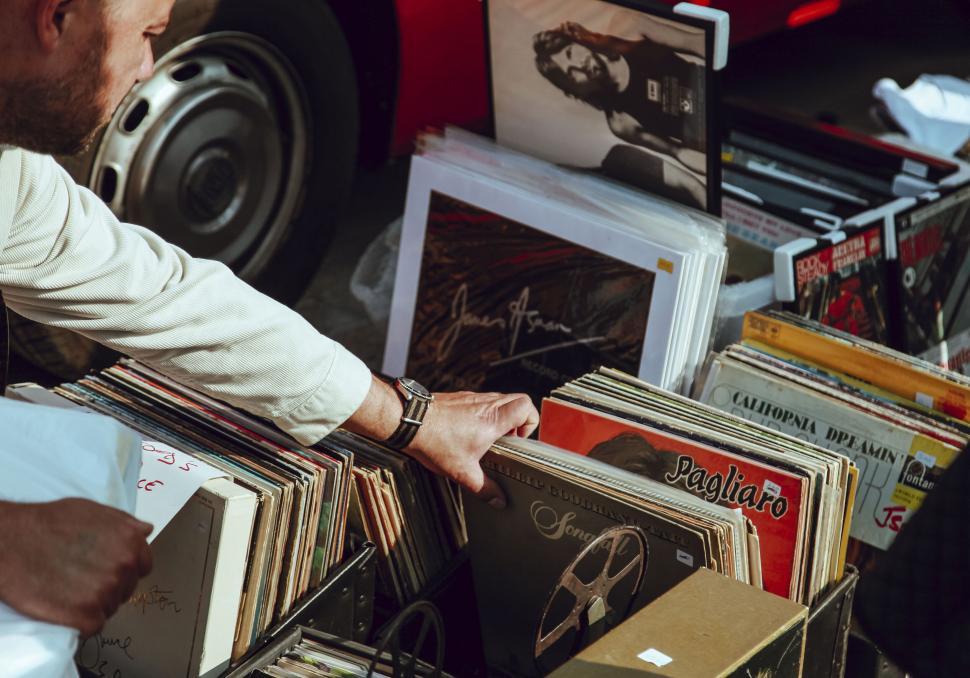
5 Essential Tools Every Vinyl Collector Should Own
Building a vinyl collection is about more than just buying records - it's about preserving musical history. But without the right tools, you might be accidentally damaging your prized possessions. Whether you're a seasoned collector or just starting your record collection, these five essential tools will help you maintain, play, and showcase your vinyl properly. From cleaning must-haves to storage solutions, we're covering everything that actually matters for vinyl enthusiasts.
1. A Proper Record Cleaning Kit
Dust and grime are the silent killers of vinyl. A basic cleaning kit should include:
- Carbon fiber brush (for quick pre-play dust removal)
- Anti-static cleaning solution (skip the homemade recipes)
- Microfiber cloths (washed without fabric softener)
- For serious collectors: a vacuum-style record cleaning machine
Why Cleaning Matters
Dirty records don't just sound worse - the buildup actually wears down grooves over time. A clean record can last decades longer than a neglected one.
2. Quality Inner Sleeves
Those paper sleeves your records came in? They're basically sandpaper for your vinyl. Upgrade to:
- Polyethylene-lined sleeves (reduce static and scratches)
- Round-bottom sleeves for easier insertion
- Archival-quality materials that won't degrade over time
| Sleeve Type | Protection Level |
|---|---|
| Original Paper | Poor - causes scratches |
| Polyethylene | Good - basic protection |
| Rice Paper/Poly | Best - anti-static and archival |
3. A Good Turntable Setup
Your record player is only as good as its components. Don't overlook:
- Adjustable counterweight (prevents groove damage)
- Replaceable stylus (budget $50+ for a decent one)
- Proper phono preamp (built-in ones often disappoint)
Turntable Maintenance Basics
Clean your stylus weekly with a stylus brush. Check alignment annually. Store your turntable away from speakers to prevent feedback.
4. Outer Sleeves for Album Covers
Protecting the jacket is just as important as protecting the record:
- 3mil polyethylene sleeves provide basic protection
- 5mil sleeves offer premium rigidity
- Look for resealable options for extra dust protection
5. A Proper Storage System
How you store records affects their longevity. Essential elements:
- Vertical storage only (no stacking!)
- Climate control - aim for 65-70°F and 45-50% humidity
- Kallax shelves from IKEA are the collector's standard
- Keep away from direct sunlight and heat sources
Storage Don'ts
Avoid attics, garages, and basements. Don't pack records too tightly - they need to breathe.
Bonus: Nice-to-Have Extras
While not essential, these tools elevate the collecting experience:
- Record weight/stabilizer (reduces vibrations)
- Mobile cleaning pen for record shopping
- Digital stylus scale ($20 well spent)
- Groove guide for tracking inner sleeves
Final Thoughts
Great vinyl collecting isn't about having the most records - it's about caring for the ones you have. With these five essential tools, you'll preserve your collection's sound quality and value for years to come.
Looking to expand your collection with quality records? Check out the curated selection at Hollow Bone Records - we only stock vinyl that meets our strict quality standards.
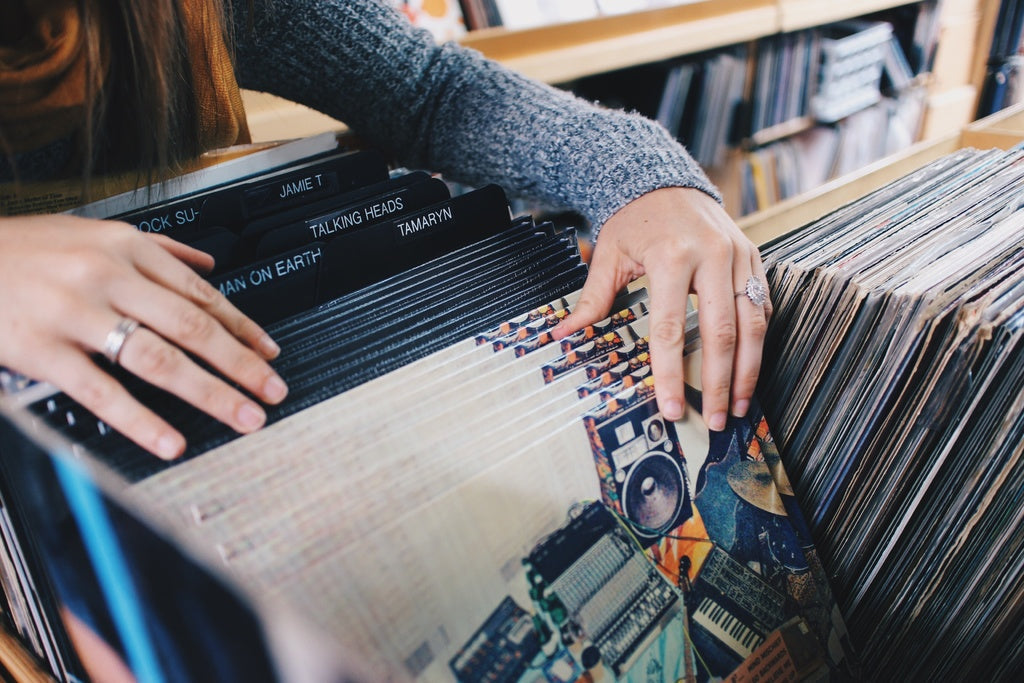
Vinyl Hunting 101: How to Find Rare Records Like a Pro
There's nothing quite like the thrill of discovering a rare vinyl record in the wild. Whether you're searching for that elusive first pressing or hunting for hidden gems in bargain bins, mastering the art of vinyl hunting takes knowledge, patience, and a bit of strategy. Here's your ultimate guide to finding rare records like a seasoned collector.
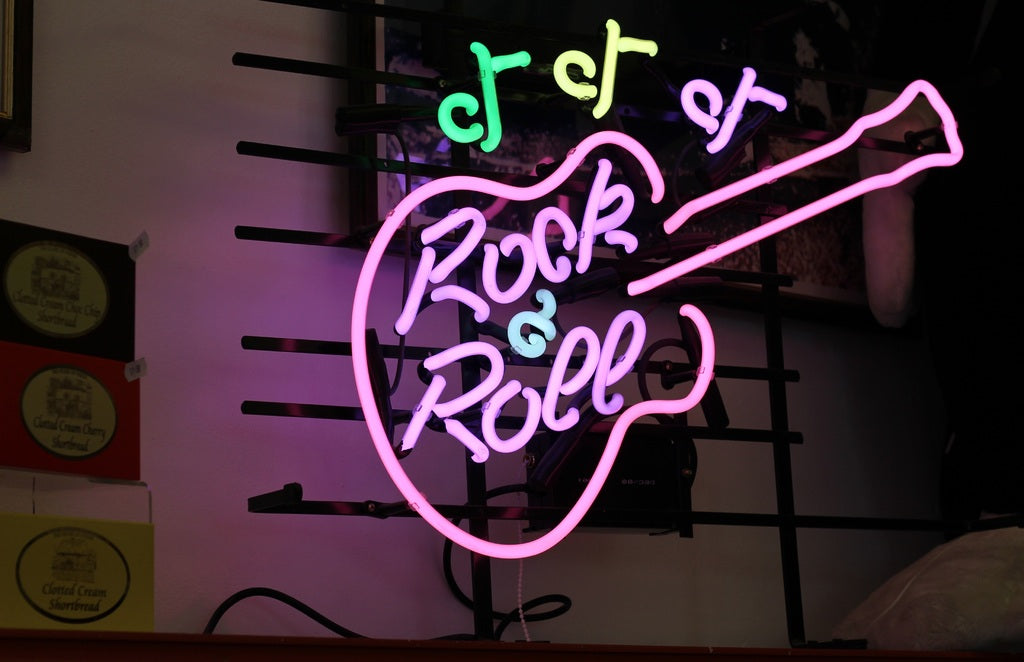
10 Classic Rock Albums Every Vinyl Collector Needs
Few things compare to the warm, rich sound of classic rock on vinyl. Whether you're a seasoned collector or just starting your record shelf, these 10 essential albums represent the pinnacle of rock 'n' roll history. From groundbreaking debuts to legendary double-LPs, these records are must-haves for any serious vinyl enthusiast.
- 1
- 2


